Your midsummer reminder of what’s coming up in six months. Enjoy the summer. Go to the beach. Eat outside. Go for a walk. Breath deeply.

Last Saturday I tweeted out a couple of screen shots showing the photo used in a CBC Prince Edward Island news story about a new Youth Advisory Council. The first showed the photo as it was used in the story itself, as it appeared in the CBC News mobile app on my phone:

The second screen shot showed how the same photo also appeared on a Dutch website advertising farewell gifts for employees:

I found the second example because the people in the photo the CBC used didn’t look familiar, and I was curious to know if they were actually “Island teens and youth” or not.
So I fed the first screen shot into the TinEye.com reverse image search and it led me to the original source of the image, a stock photo from the Shutterstock agency that has the title “People in our company get on together very well.”
On the same Shutterstock page you can find the same models engaged in all manner of other activities, from Great team is basic of success in business to Interesting idea of my colleague:

The next day, CBC broadcaster (and friend) Karen Mair commented on Twitter “wish I understood the gravity of your posts.”
A valid question for her to raise: was I merely being “gotcha!” flippant in my tweet, or is there something I’m really concerned about?
There is something I’m really concerned about.
CBC News is in the truth business; it says so right in its Journalistic Standards and Practices (emphasis mine):
We seek out the truth in all matters of public interest. We invest our time and our skills to learn, understand and clearly explain the facts to our audience. The production techniques we use serve to present the content in a clear and accessible manner.
What bothers me about the use of stock photography is that it isn’t the truth.
The five people pictured above the headline “Teens and young adults can apply to new youth advisory council” are, in fact, not real people in a position to do this: they are paid models, acting in generic scenes.
Photography is journalism just as much as words are, and in the same way that it would be unacceptable for a CBC journalist to pull generic text from a generic text agency, it’s simply disingenuous to illustrate a news story with generic photos of generic people who are not, in fact, the subject of the story.
When I consume reporting from CBC News, whether it’s online, on the radio, or on television, I want to be able to rely on the veracity of what I’m reading or hearing or watching. I don’t want to have to wonder “is that a photo of a real car accident, or one they pulled off a stock photo site?”
The fact that a stock photo was used was disclosed, both on the mobile app (if you tap on the info icon over the photo) and on the web, in the photo credit:
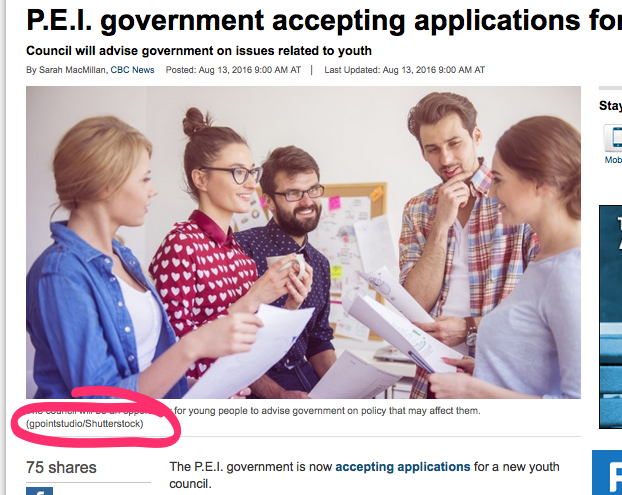
But this isn’t, for me, a question of disclosure-or-not, it’s a question of the proper role of illustrative photography in CBC journalism.
The same Journalistic Standards and Practices document has a section on Production Principles that touches more closely on this use of generic or simulated media:
A reenactment of an event must match the reality as closely as possible. When a reenactment is necessary for a proper understanding of the subject, we take care to be factually accurate, using transcriptions, minutes or official documents. We may use a transcript word for word or set the reenactment in the location where the actual scene occurred. To eliminate any risk that the audience will confuse the reenactment with the reality, we will ensure that the audience can clearly identify the reenacted scenes.
Other methods of illustrating a subject may attempt to describe a situation in general terms without pretending to be a precisely accurate rendering of reality. Such methods can be used, subject to certain conditions.
A simulated scene aims to evoke or give an impression of an event, its protagonists, their actions and the place where the event occurred. A simulated scene is produced and presented in a way that makes clear it is an evocation rather than a precise depiction of reality. If a risk of confusion remains, we advise the audience that the scene is simulated not real.
Generic scenes are commonly used in audiovisual production. These are often everyday actions like walking, answering the phone, looking at a document, closing a door. These scenes clearly serve as general illustration and in no way pretend to describe real facts precisely.
I don’t think the use of generic stock agency models standing in for real Prince Edward Island teens and young adults meets this standard: these models are not a reasonable facsimile of Island teens and young adults, their inclusion is not an accurate depiction of what the Youth Advisory Council will look like or how it will operate (which is largely unknown at this point), and its inclusion is not necessary for the proper understanding of the story.
Although the use of a stock photo is disclosed in the photo credit, the typical reader would, I hold, be left with the impression that this was a real photo taken on Prince Edward Island of something related to the new council.
In the end I propose a simple standard for the inclusion of photos in digital stories:
- Does the inclusion of the photo help tell the story?
- Is the photo a real photo of something actually related to the story?
Unless the answer to both questions is yes, leave the photo out.

Not a photo of me writing this blog post. Not a photo of me at all. Don’t know who it is. He could be playing music. He has a nice hat though.
(“Typing” by photographer Enric Fradera. Creative Commons Attribution-NoDerivs 2.0 Generic license)
Next in the series (with torrential rain mixed with the plaintive sounds of Anne and Gilbert in the background):
- Royal Pita Bakery in West Royalty (in behind Kent Building Supplies) has an amazing-to-watch pita-making-machine (the “blow the bread up like a balloon” phase is especially intriguing). As a result, you can stop in and buy pita bread fresher than you’ve likely ever had it. A 5-pack of the smaller size is only $2.25. Take the kids!
- Angel’s Cheddar-Jalapeño Bread at the Charlottetown Farmer’s Market. It’s very, very good.
- Starbucks Cold Brew at the West Royalty drive-thru. I dislike almost everything about Starbucks, but when we’re out and about at the edge of the city on a hot summer day, in our 17 year old air conditioning-free car, a quick dip into the drive-thru for a cold brew is just what I need.
Perhaps an homage to my friend Ann’s long-running One Good Thing column in The Buzz, and certainly influenced by the excellent weekly Cool Tools newsletter, here are three new things I’ve discovered in the last while.
- Stranger Things on Netflix. I’ve never been a fan of the “there’s something odd going on in this town” genre, but this show is firing on all cylinders.
- Sriracha Peas from Top Fresh Asian Market. They come in a pop-top can. They’re very pleasantly hot. Maybe too hot for some.
- Buddha Bowl from Receiver Coffee. It’s my new favourite lunch thing.
That’s it.
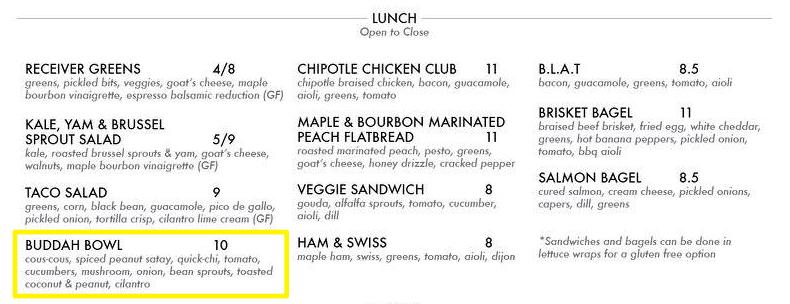
I’ve lived in Charlottetown for 23 years, but I’ve never seen Charlottetown Harbour in a kayak. Until this morning.
With a free morning today, a morning pleasantly cool and free of wind, Oliver and I headed down to Paddles PEI at the Charlottetown Yacht Club and rented a double kayak for an hour for $35. It came with life jackets, paddles, and friendly service. We entered the kayak from an easy-access dock with rollers on it; we didn’t even need to get wet.
Over our hour on the water we paddled out of the Yacht Club and west toward Victoria Park, staying close to shore. We explored the basic in front of Government House, then paddled back around the old Coast Guard Wharf to check out the Charlottetown Tide Station from the water. Exiting and entering through the Yacht Club gave us a chance to see the three super-yachts (think “boats that carry their own jet skis”) up close.
It was a terrific way to spend a summer morning, and I recommend it to anyone.
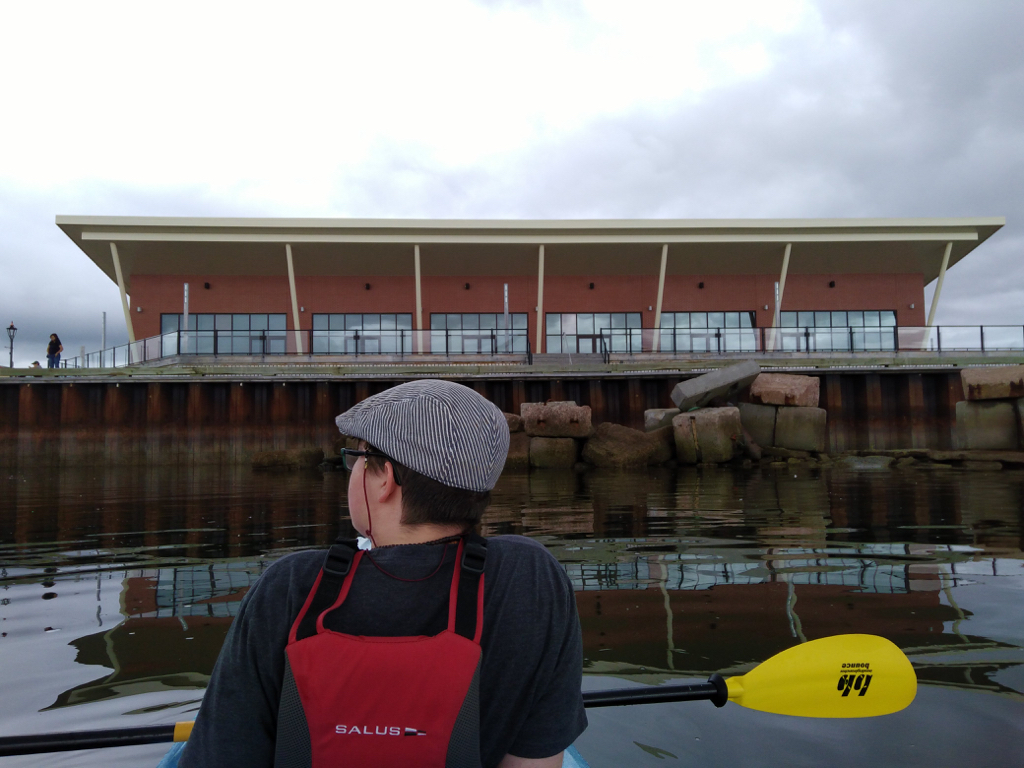
The CBC is reporting P.E.I. premier wants 2nd ferry for Caribou-Wood Islands run. This is precisely the moment for which I equipped the Premier, upon his assuming office last year, with a pocket-sized handy reference to the Terms of Union by which Prince Edward Island and Canada joined in 1873. It’s time to unfurl the terms.

The millennials of Prince Edward Island excel at conjuring interesting events. One of these is The Island Fringe Festival, which runs this week. I’m a sponsor, both because I’m a fan and because of excellent urging skills of Josh Coles and Ann Thurlow.
By way of ensuring that more people attend, but really because if something isn’t on my calendar it might as well not be happening, I’ve distilled the festival’s calendar of shows into a handy digital form suitable for integration into your digital lifestyle:
- iCal Feed – subscribe with your desktop or mobile calendar app at this and, presto, you’re always up to date.
- iCal File – the raw calendar data should you wish to brew your own custom version of the schedule.
- HTML – just a regular old calendar
This year’s Fringe promises to be the best yet, and, armed with my trust calendar, I am planning to wring everything last morsel from it.
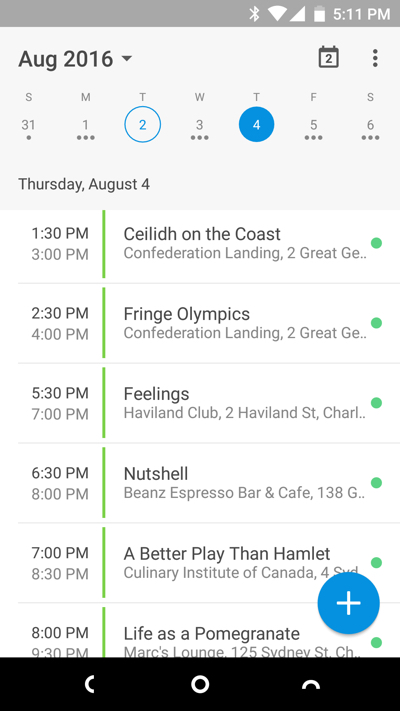
I finished printing the pages of my book of klischees today. And on the last page is this gem, the Arms of Canada. What a lost art it is, that of rendering texture in black and white. Next step: binding.
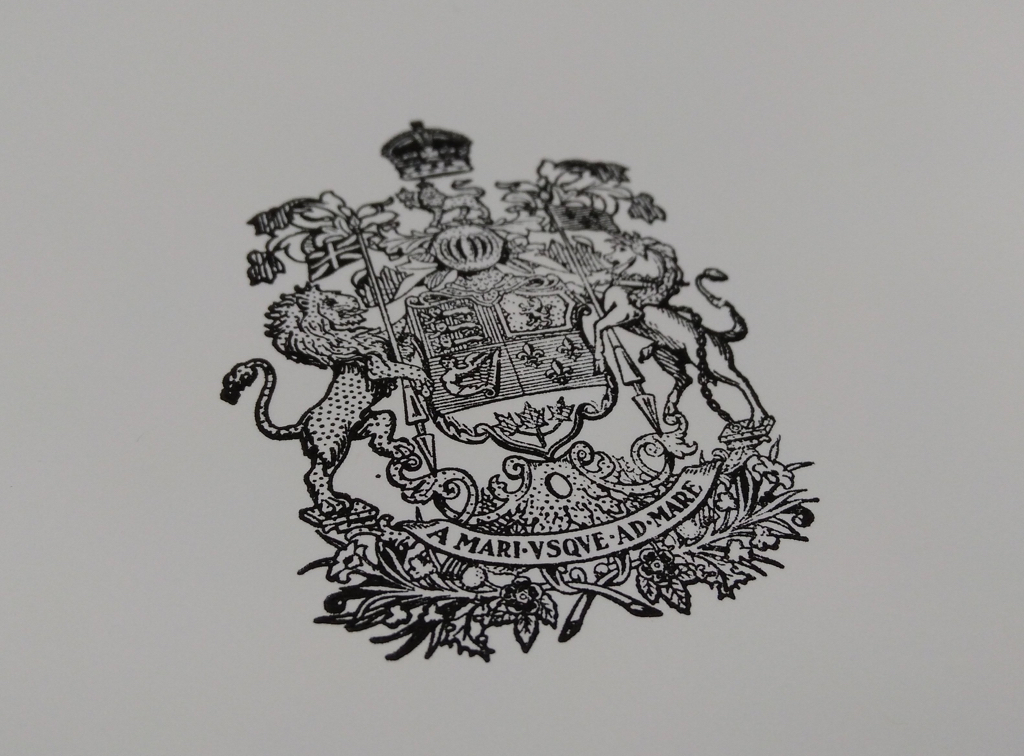
Oliver and Derrick are spending the night in New Glasgow camping. Oliver’s leaving his laptop at home; he’s very, very rarely without it. And so this dramatic announcement of his Entering The Real World on Facebook:

Oh how I love my son.
Since the launch of IslandNewspapers.ca, the Robertson Library project to digitize the archives of The Guardian newspaper, I’ve been reading the 100-years-ago-today paper every day (you can do this yourself, if you like, by following this Tumblog).
It’s been a bracing time to be reading the headlines these last few years, as World War One has been raging in Europe, and barely a day goes by without some report of a sanguinary battle. If nothing else this daily read has given me a palpable sense of how long the war went on, and how, in the middle of it, it was frequently thought to be almost over.
It’s not every day I pick up the paper, however, and read of an event that involved my family directly; this morning, though, came the headline “Disastrous Fires in North Ontario” with the subhead “Eighty people known to have perished. Towns of Nushka, Timmons, Cochrane and Matheson wiped out. Many bodies recovered”:
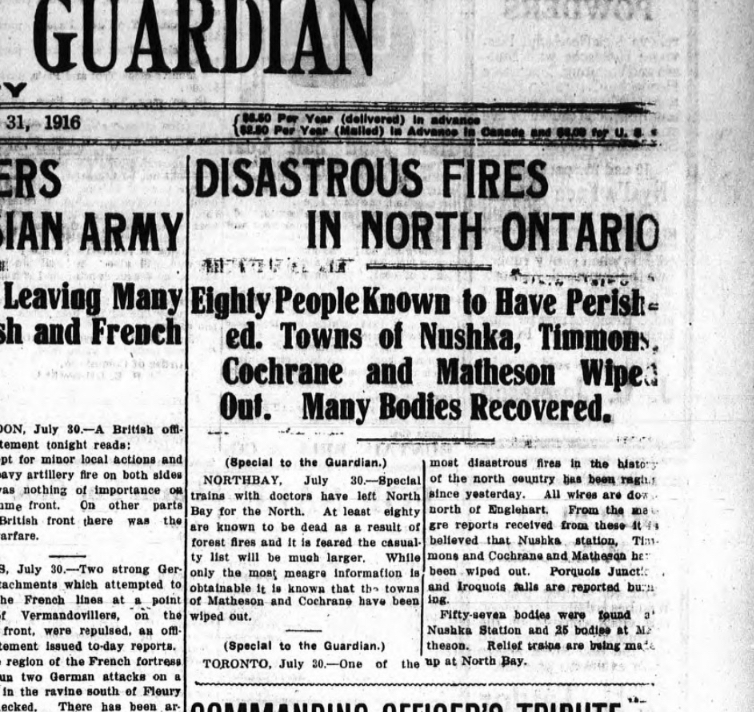
My great-grandparents, Edgar and Emmeline Caswell, moved to Cochrane in 1909, six years before this fire. Here’s how the Northland Post told the story of this move in Edgar’s obituary:
It was at the beginning of 1909 that Ed reached Cochrane, his family following in the spring. He carried on as a builder and contractor, one of his first contracts being for the foundation of the new station. Then he started a grocery store, which Mrs. Caswell carried on for a time while her husband worked out of town on railway construction. Following an attack of typhoid, however, he returned to town, sold the store, and entered the service of the municipality in May, 1913. During the next thirty years he filled practically every position on the town staff outside the offices. He was town foreman and building inspector for many years, and at one time even served as acting chief of police.
The fire of 1916 was, in fact, the third fire to “wipe out” the town of Cochrane.
First came the fire of 1910. Edgar’s biographer, Dick Bourgeois-Doyle, tells the story of an August night that summer:
Ed Caswell was awakened in the middle of the night by the sound of gunfire in the streets near his home. The bank manager had emptied his shotgun into the sky when he realized that people were not being roused by the engine whistles and all the yelling. Fire had broken out for unknown reasons along the town centre. For the next three hours, Ed and his neighbours ran, sweated, and strained to kill the fires in heroic – but nearly hopeless – bucket brigades, ultimately saving only one house on the two main streets.
Then, in the summer of 1911, just a year later, the Great Porcupine Fire, also reported in The Guardian, struck the town:
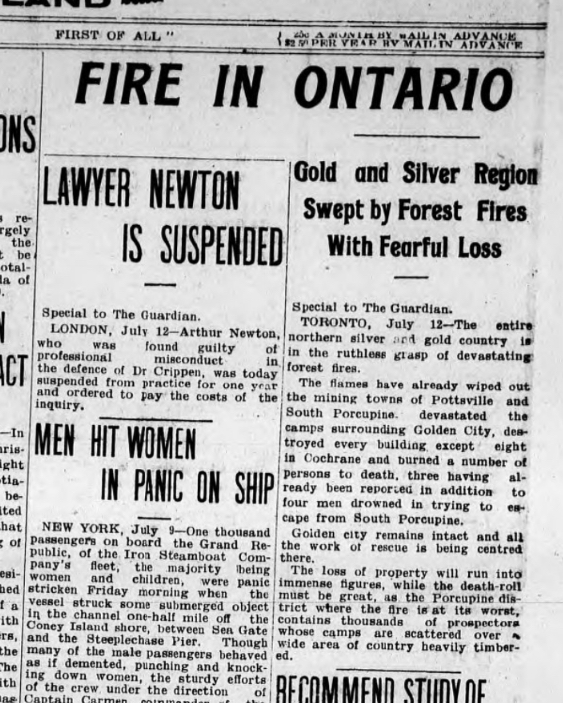
While that fire devastated the town of Cochrane, it was a fire earlier the same week that had a even more devastating effect on Edgar and Emmeline and their children, for a fire that broke out in a 4th avenue hotel, on the same side of the street as their house and general store, consumed the block. Edgar’s obituary reports that his family’s “possessions were wiped out in the 1911 conflagration.” In his biography of Edgar, Dick Bourgeois-Doyle elaborates:
The family lost everything save a few personal effects, and Ed and his wife had some difficult decisions. With this personal tragedy, they had no choice but to recognize the perils of life in the northland and the cost of the opportunity it offered. As they sifted through the scorched residue of their business and their home, they had to focus on the short term, finding shelter and food for the children.
Only five days later the Great Porcupine Fire bore down on the town. Many residents sought refuge in Lake Commando, in the heart of the town. Others, including Emmeline and their children, were loaded into boxcars and shuttled east on the railway beyond the reach of the fire. Because of the smaller fire that took their home the week earlier, the family had gathered what personal possessions they had into a trunk that made it out of town that day; as a result, rendering its contents some of the only records of Cochrane’s early history.
Although 3,000-odd residents were wiped out by the 1911 fire, no lives were lost in Cochrane proper, and the town set to rebuild itself.
The fire of 1916 — 100 years ago this weekend — was much worse than those of 1910 and 1911. This fire, dubbed the Matheson Fire, was again devastating to the town, and this time many lives were lost.
After the fire, already Town Foreman, Edgar had the additional duty of Fire Chief of Cochrane added to his duties, aided in the position by Emmeline, dubbed Cochrane’s “first firelady,”
The town never burned to the ground again. And, indeed, became a model community for its fire safety and firefighting practices.
Here is how the Northland Post reported my great-grandparents’ retirement from firefighting in 1946, thirty-three years after entering the service of the town:
Reminiscing of pioneer days gone by were members of Cochrane’s Volunteer Fire Brigade, their families and friends when they gathered at a banquet in the Stevens Hotel last week to pay tribute to Fire Chief Ed Caswell and Mrs. Caswell on the eve of the former’s retirement.
In appreciation for thirty-three years of public service the couple were presented with a thirty-four piece set of Rogers Brothers Silver.
The retiring Fire Chief was main speaker for the evening.
“It has been one of the greatest pleasures and greatest privileges in my life,” said Mr. Caswell, “to have been chief of Cochrane’s Volunteer Fire Brigade.”
Continuing he said that the Cochrane Brigade is the pioneer brigade in the North and was the first organized (1911) north of Englehart. Mr. Caswell complimented the ‘women members’ of the brigade for their part in helping to protect Cochrane from fires. He attributed to them much of the success achieved in establishing the fire-conscious spirit among the people of Cochrane today.
His own wife has justly earned the title of Cochrane’s First Firelady. Many times firemen have returned from fighting a fire to find Mrs. Caswell with a tasty lunch and stimulating hot coffee ready for them at the Firehall.
His parting words were to brigade members: “I am retiring tonight without a regret in the world. Although I may be getting old and dropping off, my heart is still in the work as much as ever, and I’ll continue to stand by the firemen to help them protect the town of Cochrane from fire.”
In a tragic irony that still brings tears to my eyes when I think of it, barely a month later my great-grandmother was burned to death when her housecoat touched an electric fireplace. Here’s Bourgeois-Doyle’s description of her death:
Frail and ill, Emeline Caswell was often struggling to stay warm. The small electric heater in the living room seemed particularly ineffective against the chill of this cold winter’s day, and she leaned over it to adjust the heat. Her dropping robe brushed the elements in the heater and burst into flames so quickly and widely that she was overcome by the searing force of the heat and the shock. Ed’s beloved wife was knocked to the floor wrenching in pain.
When Ed and the others came back to the apartment hours later, they found her scarcely conscious and barely alive, suffering extensive and gruesome burns. Cochrane in 1946 had much better medical services than it did after the forest fires decades earlier, and these services included those of the well-equipped Lady Minto Hospital. Yet despite every effort to comfort and save the fire chief’s seventy-three-year-old wife, Emeline lingered horribly for eighteen days before finally succumbing to the burns and finding an end to the ghastly suffering.
Here’s how her death was reported in The Ottawa Journal.
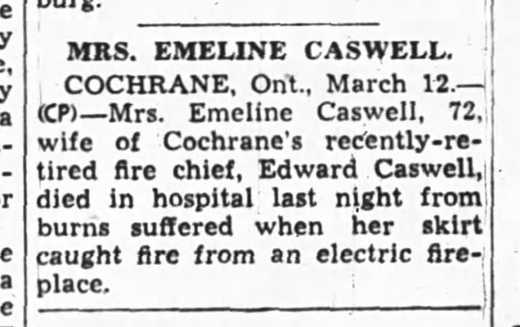
Edgar lived another 4 years, dying from stroke in 1950. One can only imagine the grief that lurked in him for those last years of his life.
I’m so proud of the role my great-grandparents – and their children, and their children’s children – played in the development of Northern Ontario. Not only were they challenged by fire, but by two world wars, by influenza, by typhoid, and by the simply fact of carving a new settlement out of the bush.
And I’m both happy, and chastened, to be reminded of this by an item in The Guardian 100 years on.
 I am
I am